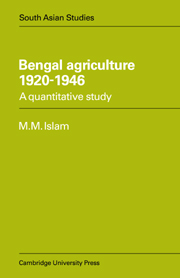Book contents
- Frontmatter
- Contents
- List of tables
- List of figures
- Foreword
- Preface
- Introduction
- PART ONE
- PART TWO
- 4 Price elasticity of acreage under cultivation
- 5 Capital in agriculture
- 6 Agricultural credit and the Co-operative Credit Movement
- 7 Bengal landlords and agriculture
- Conclusion
- Appendix: statistical tables
- Select bibliography
- Index
7 - Bengal landlords and agriculture
from PART TWO
Published online by Cambridge University Press: 15 December 2009
- Frontmatter
- Contents
- List of tables
- List of figures
- Foreword
- Preface
- Introduction
- PART ONE
- PART TWO
- 4 Price elasticity of acreage under cultivation
- 5 Capital in agriculture
- 6 Agricultural credit and the Co-operative Credit Movement
- 7 Bengal landlords and agriculture
- Conclusion
- Appendix: statistical tables
- Select bibliography
- Index
Summary
One argument that featured prominently in the discussion leading to the introduction of the Permanent Settlement in Bengal was that such an institutional arrangement would act as a radical incentive to agricultural development. Since the zamindars would have proprietary rights to the land and the demands of the government on them would not increase, the landlords would, it was believed, in their own interest invest their profits in land. Thus, Cornwallis asserted, ‘Land property will acquire a value hitherto unknown in Hindustan and the large capital possessed by many of the natives in Calcutta which are now employed in usury or monopolising salt and other necessaries of life will be appropriated to the more useful purposes of purchasing and improving land’. There were critics of this plan even at the time of its introduction and the experience of the subsequent years, when the failure of the expectations of Cornwallis became more and more clear, added both to the number of critics as well as to the severity of their denunciation. The Government of India believed that the desired effectiveness of the permanent settlement was not ‘supported by the experience of any civilised country’ and that under this system the ‘cultivator was rack-rented, impoverished and oppressed’. Again, according to the Land Revenue Commission the ‘Permanent Settlement imposed on the province an iron-framework which has had the impact of stifling the enterprise and initiative of all classes of people’. It has been generally held that the Bengal ‘monied class’ invested their capital in buying or taking leases on land from the old landed class and that this practice assumed such proportions as to dry up capital for commercial or industrial enterprise.
- Type
- Chapter
- Information
- Bengal Agriculture 1920–1946A Quantitative Study, pp. 184 - 199Publisher: Cambridge University PressPrint publication year: 1979



